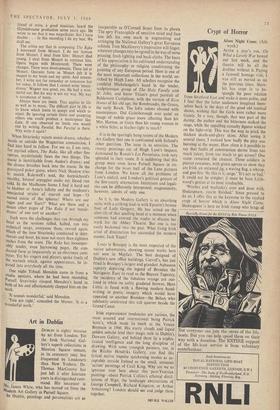Art in Dublin
DUBLIN is eighty minutes by air from London. Yet the Irish National Gal- lery's superb collections in Merrion Square remain, in its centenary year, less frequented by Londoners than New Yorkers. Dr. Thomas MacGreevy has just left it after fourteen years in distinguished corn- s _ – mand. His successor is 4:4_r. James White, who has moved on from the Modem Art Gallery in Parnell Square.
In Dublin, paintings and personalities are as inseparable as O'Connell Street from its ghosts. The spry Francophile of sensitive mind and face has left his own mark in augmenting and arranging the National Gallery's great European schools. Tom MacGreevy's inspiration will linger, whatever changes may be agreed in the way of some pruning, fresh lighting and back-cloths. The basis of his appreciation is his cultivated understanding of the philosophy or religion conditioning the painting of any European period. Here is one of the most important collections in the world, en- riched by Hugh Lane. All scholars recognise the youthful Michelangelo's hand in the tender, sculpturesque group of The Holy Family with St. John, and know Titian's great portrait of Baldassare Castiglione, with the version of Ecce Homo of his old age, the Rembrandts, the Greco, the early Bosch. The lofty salons abound with masterpieces. Did Gainsborough ever paint an image of nubile grace more affecting than his Mrs. Horton, or Goya than his young woman in a white fichu, as feather-light in touch?
It is in the sparingly hung rooms of the Modern Art Gallery that one is confronted with Ireland's other partition. The issue is as sensitive. The twenty paintings out of Hugh Lane's bequest, dominated by Renoir's Les Parapluies, look very splendid in their room. It is saddening that this group must soon leave Parnell Square in ex- change for the lesser half of the Lane pictures from London. We know all the problems of Lane's codicil, and London's political gesture of the five-yearly alternation. Intentions and legali- ties can be differently interpreted; magnanimity, however, admits of only one.
As it is, the Modern Gallery is an absorbing suite, with a striking lead-in with Epstein's bronze bust of Lady Gregory. He has seized on the alert tilt of that quelling head at a moment when someone had entered the studio to discuss her work for the Abbey Theatre. But one is too easily beckoned into the past. What living Irish artist of dinstinction has succeeded the modern master, Jack Yeats?
Louis le Brocquy is the most respected of the native adventurers, showing recent works here not seen in Mayfair. The best designed of Dublin's new office buildings, Carroll's, has just fitted le Brocquy's largest and grandest Aubusson tapestry depicting the legend of Brendan the Navigator. Easy to read as the Bayeux Tapestry, the incidents of the fabulous voyage are out- lined in white on softly gradated browns. Here Celtic is fused with a flowing modern hand- writing in poetic imagery which would have appealed to another Brendan—the Behan who jubilantly celebrated this still quarter beside the Grand Canal.
Irish expressionist tendencies are various, the most assured and international being Patrick Scott's, which made its mark at the Venice Biennale in 1960. His starry clouds and liquid golden nebuloe lend their magic now to Dublin's Dawson Gallery, and behind them lie a sophis- ticated intelligence and the long discipline of drawing. With some youngish painters, too, in the Ritchie Hendriks Gallery, you find this lyrical native impulse quickening modes as ac- ceptable outside Ireland as the small, sensuous 'action' paintings of Cecil King. Why are we so ignorant over here about this .post-Yeatsian painting—about Patrick Collins's ethereal distil- lations of Sligo, the landscape abstractions of George Campbell, Richard Kingston, or Arthur Armstrong? London should see and judge them together.
NEVILE WALLIS






























 Previous page
Previous page